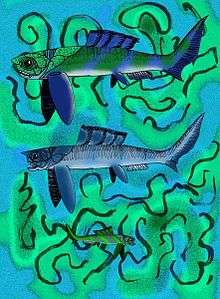Rhinosteus
| Rhinosteus Temporal range: Late Frasnian[1] | |
|---|---|
 | |
| R. tuberculatus, R. traquairi and R. parvulus | |
| Scientific classification | |
| Kingdom: | Animalia |
| Phylum: | Chordata |
| Subphylum: | Vertebrata |
| Class: | Placodermi |
| Order: | Arthrodira |
| Suborder: | Brachythoraci |
| Infraorder: | Coccosteina |
| Superfamily: | Dinichthyloidea |
| Family: | Selenosteidae |
| Genus: | Rhinosteus |
| Type species | |
| Rhinosteus traquairi Jaekel 1911 | |
| Species | |
| |
| Synonyms | |
| |
Rhinosteus is a genus of small to medium selenosteid arthrodire placoderms known from the Upper Frasnian Kellwasserkalk facies of Late Devonian Germany[1] and Morocco.[2]
Rhinosteus is a typical genus of Kellwasserkalk selenosteids, with short cheeks, and slender inferognathal plates. However, two of the species, R. traquairi, and R. tuberculatus, have long, pointed rostrums, and tubercles on the plates. In R. traquairi, the rostrum is sharply pointed, extending beyond the snout, and the tubercles are small and irregularly placed. In R. tuberculatus, the rostrum is bluntly pointed, and the tubercles are large and plentiful. The species, R. parvulus, has a blunt rostrum that does not extend beyond the snout, and lacks tuberculation altogether.[1] The average skull length of R. traquairi is about 11 centimetres. The average skull length of R. tuberculatus is 15 centimetres, while that of R. parvulus is 4 to 6 centimetres.
R. traquairi and R. tuberculatus are both endemic to Bad Wildungen. R. parvulus is also found in Bad Wildungen. Rücklin (2011) discusses how specimens of small Rhinosteus have been found in the Kellwasserkalk facies of the Anti-Atlas of Morocco, and are tentatively referred to R. parvulus due primarily to their small size.[2]
References
- 1 2 3 Denison, Robert (1978). Handbook of Paleoichthyology, Volume 2, Placodermi. New York: Gustav Fischer Verlage. p. 97. ISBN 9780895740274.
- 1 2 RÜCKLIN, MARTIN (January 14, 2011). "First selenosteid placoderms from the eastern Anti-Atlas of Morocco; osteology, phylogeny and palaeogeographical implications". Paleontology. 56 (1): 25–62. doi:10.1111/j.1475-4983.2010.01026.x.